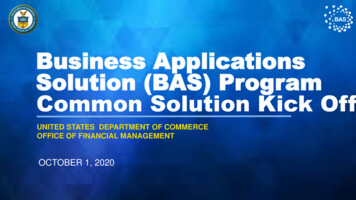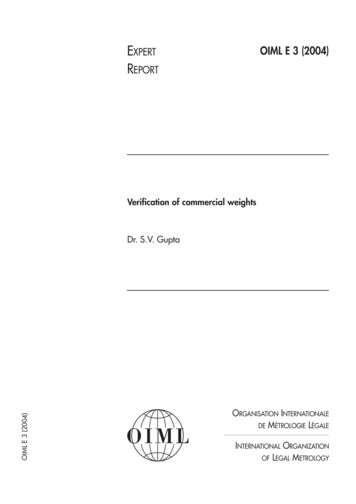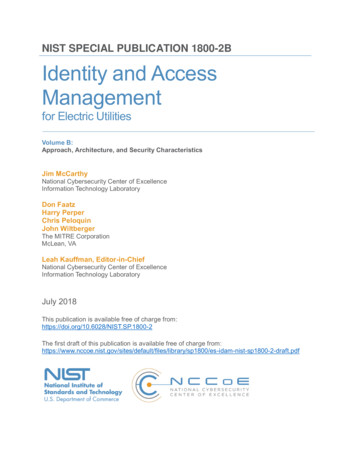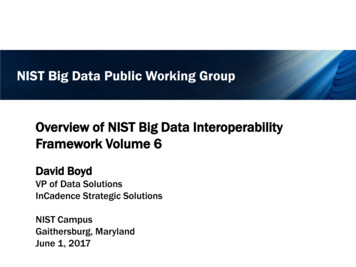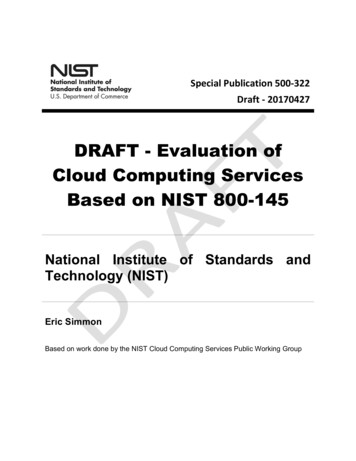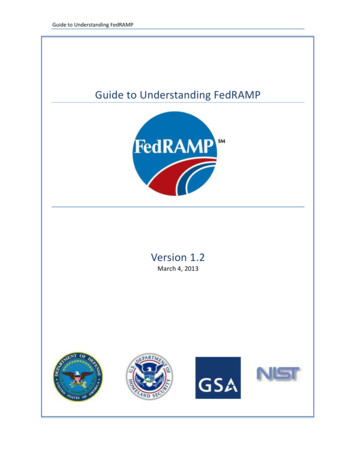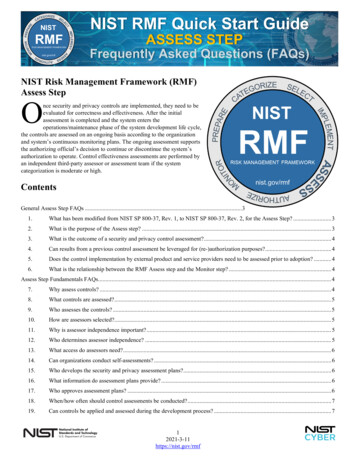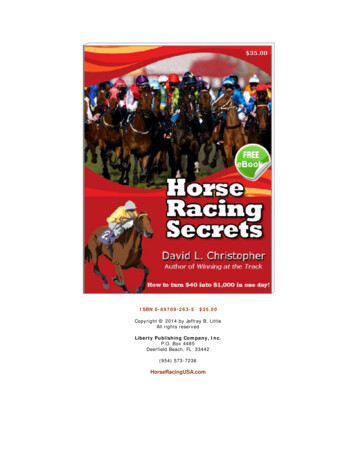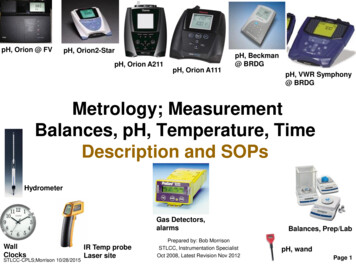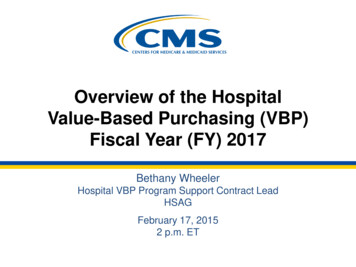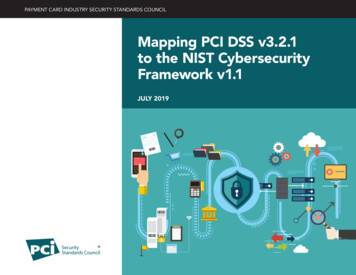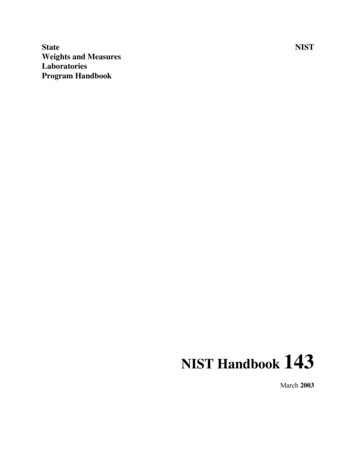
Transcription
StateWeights and MeasuresLaboratoriesProgram HandbookNISTNIST Handbook 143March 2003
NIST Handbook 143iiMarch 2003
PrefaceThe National Institute of Standards and Technology (NIST) manages the State Laboratory Programthat began with the New State Standards Program established by Congress in 1965 as part of itscontinuing support to the States. This program of the NIST Weights and Measures Division (WMD)is designed to provide guidance, technical support, and assistance to State legal metrologylaboratories to ensure accurate and traceable measurements from NIST to the local jurisdictions.The program operates through continued partnership with the State laboratories to manage numerousmeasurement-related activities.Significant changes have been made to the program of Recognition for the States and to thisProgram Handbook since the first edition was published in 1985. The program has incorporatednational and international standards; although WMD does not provide formal accreditationaccording to ISO Guide 58, and although the program is operated independently from the NationalVoluntary Laboratory Accreditation Program (NVLAP), the general and technical criteria used inboth programs are nearly identical.The following list shows key changes in this edition of the Handbook: Information associated with the National Type Evaluation Program (NTEP) is no longercovered in this program handbook. Parts 2 and 3 are policy and procedure information specific to WMD operations andRecognition process; Figure 1 is a flow chart showing the Recognition process. Parts 4 and 5 substantially contain ISO/IEC 17025:1999 (previously these sectionsreferenced ANSI/NCSL Z540-1-1994 (parts I and II) with NVLAP additions, WMD Notes,and minor editorial changes for clarity). WMD Notes added to parts 4 and 5 are additionalpolicy or requirements that apply generally to all legal metrology laboratories without regardto Recognition level. Part 6 is taken from the NVLAP Calibration Laboratories Draft Technical Guide (1994Draft, as incorporated in the 1996 and 1997 editions of this Handbook), but edited for thispublication. WMD and the National Conference on Weights and Measures (NCWM) ISO9000 Task Force prepared the mass and volume sections and reviewed them at a specialNVLAP workshop in December 1992 (mass criteria only); at a NVLAP workshop inNovember 1993; at all six regional metrology meetings in 1993 and 1994; and at the 1994NCWM meeting. Laboratories performing temperature measurements were given theopportunity to review the temperature section. Diane Lee (NIST) prepared the moisturesection; it was reviewed at the Southeastern Measurement Assurance Program (SEMAP)regional metrology meeting in 1993. These sections have all been reviewed and updated forthis 2003 edition.NIST Handbook 143iiiMarch 2003
For the 1997 edition, NIST management made changes in the WMD State LaboratoryProgram. As a result, the 1997 Handbook was revised to delete references to accreditation.References to “accreditation” were replaced with references to “Recognition;” references toa “certificate of accreditation” were replaced with references to a “Certificate ofMeasurement Traceability;” and references to the WMD State Laboratory Program as an“accreditation program” were replaced with references to a “measurement assuranceprogram.”Note regarding SI units:Appropriate SI units of measure have been used throughout this document where possible. Sincecommercial applications in the United States use units other than SI or other accepted metric units,this document may reference other common units in current use.NIST Handbook 143ivMarch 2003
Acknowledgments and HistoryThis Program Handbook, first published by Henry V. Oppermann and John K. Taylor in 1985,documented and formalized the certification program whereby NIST Recognized the capabilities ofState legal metrology laboratories. Prior to that time, the NIST/WMD issued “Certificates ofParticipation” to States participating in the program. In 1985, WMD started certifying laboratoriesagainst the criteria in Handbook 143, Program Handbook. The 1985 criteria were based onInternational Standards Organization (ISO/IEC) Guide 25 (1982), General Requirements for theCompetence of Calibration and Testing Laboratories.The WMD began the process of updating this Program Handbook in 1991. Due to the manyactivities related to ISO 9000 in the United States and questions regarding how those activitieswould impact the State laboratories, ISO standards were circulated to the State laboratories in 1991.The National Conference of Standards Laboratories (NCSL), Total Quality Management (TQM)Committee also started working on the development and adoption of a single U.S. national standardfor calibration laboratories in 1991. The NCSL TQM Committee included representatives fromNIST, Department of Defense, Department of Energy, Nuclear Regulatory Commission, FederalAviation Administration, and numerous industries.In 1992, the National Conference on Weights and Measures (NCWM) established an ISO 9000 TaskForce. After review of the 1985 version of the Handbook and ISO/IEC Guide 25 to determine theconformance status of State laboratories, the group recommended the use of one standard in theUnited States (consistent with the NCSL position) for the accreditation of calibration laboratories to:1)reduce the number of redundant laboratory audits;2)improve measurement compatibility and acceptance of measurement results betweenlaboratories in the United States and internationally; and3)comply with the ISO-series standards for quality.The NCSL “TQM Committee” became an official ANSI standards writing body (ANSI CommitteeZ 540) in 1994 and published the U.S. standard as Z540-1-1994. ANSI/NCSL Z540-1-1994incorporated ISO Guide 25 and Mil-Std-45662A. Since NCSL published the standard in 1994:1) the Department of Defense rescinded Mil-Std-45662A in favor of the Z540-1-1994 standard;2) the NIST National Voluntary Laboratory Accreditation Program (NVLAP) adopted andreferenced ANSI/NCSL Z540-1-1994;3) the American Association for Laboratory Accreditation (A2LA), a private accrediting body, alsoadopted the standard; and4) the NIST/WMD incorporated the standard into Parts 5 and 6 of the 1996 and 1997 editions ofthis Handbook. Additional requirements consistent with NVLAP requirements and with theneeds of the legal metrology system were included.In 1997, NIST management made the decision that NIST would operate only one formalaccreditation program: the National Voluntary Laboratory Accreditation Program (NVLAP).NIST Handbook 143vMarch 2003
Therefore, all references to accreditation by WMD were changed to Recognition and WMD ceasedissuing Certificates of Accreditation. WMD monitors the level of State compliance to thisHandbook and other laboratory quality standards to ensure that adequate accuracy, traceability, anduniformity are maintained in State weights and measures laboratories.In 1999, ISO/IEC Guide 25 was revised and became the international standard ISO/IEC 17025. This2003 edition of NIST Handbook 143 incorporates revisions to the procedures and generalrequirements of the NIST Weights and Measures Division (WMD) Measurement AssuranceProgram for State Laboratory Recognition. The WMD procedures were revised to ensure continuedconsistency with international standards and guidelines, specifically those currently found inISO/IEC 17025:1999, General requirements for the competence of testing and calibrationlaboratories.The requirements in Sections 4 and 5 of this edition are nearly identical to those found in clauses 4and 5 of ISO/IEC 17025:1999. They must be met in order for a laboratory to be Recognized ascompetent to carry out tests and/or calibrations. Major changes from the previous edition of thehandbook include the following: In Section 4, Management requirements, there are additional or changed requirements in theareas of document control; requests, tenders, and contracts; purchasing; non-conforming work;corrective action; preventive action; and records. These additions and changes incorporateand/or are consistent with ISO 9001:1994 requirements. A new clause, Service to the client,prescribes cooperation with clients and provides guidance on such cooperation. In Section 5, Technical requirements, the requirements are described in greater detail, but mostconcepts are not “new” for accredited laboratories. There is continued reference to client needsand greater emphasis and/or more detailed requirements on method validation; estimation ofmeasurement uncertainty/traceability for testing laboratories; and provision for inclusion ofinterpretations and opinions on test reports. A sampling plan will be required where methods orspecifications do not specify sampling procedures.This 2003 edition supersedes and replaces the 1997 edition of NIST Handbook 143.NIST Handbook 143viMarch 2003
Table of ContentsPreface .iiiAcknowledgments and History. v1.Program Summary . 22.General Information and Operational Requirements . 43.Recognition Process. 10Table 1. Submission requirements for recognition . 174.Management Requirements for Accreditation . 185.Technical Requirements for Accreditation . 306.Specific Technical Guidelines . 49Table 3. Recognition parameter summary . 506.1Technical Criteria for Dimensional Laboratories . 516.2Technical Criteria for Mass Laboratories . 56Table 4. Mass calibration echelons. 56Table 5. Typical Ranges of Recognition for mass calibration . 57Table 6. Environmental facility guidelines for mass laboratories. 59Table 7. Environmental equipment accuracy. 60Table 8. Summary of technical criteria for mass calibration . 636.3 Technical Criteria for Volume Laboratories . 64Table 9. Typical Ranges of Recognition for volumetric calibration. 64Table 10. Environmental facility guidelines for volumetric calibration . 66Table 11. Environmental equipment accuracy. 67Table 12. Summary of technical criteria for volumetric calibration . 696.4 Technical Criteria for Hydrometer Laboratories. 706.5 Technical Criteria for Thermometer Laboratories . 736.6 Technical Criteria for Moisture Laboratories . 81Table 13. Moisture determination laboratory classifications. 81Table 14. Summary of environmental facility guidelines. 877.References. 888.Glossary . 89Appendix A. List of NIST Services . 94Appendix B. Request for Recognition, Scope of Recognition, Approved Signatories, AuthorizedRepresentative. 95Appendix C. Laboratory Assessment Checklist. 96Appendix D. Summary of Services for Laboratory Directory . 126Appendix E. Uncertainties Chart for Measurement Parameter. 130NIST Handbook 1431March 2003
1.Program SummaryState legal metrology laboratories are custodians at the State level of measurement standards thatserve as the basis for ensuring equity in the marketplace and as reference standards for calibrationservices for indigenous industry. As part of its program to encourage a high degree of technical andprofessional competence in such activities, the National Institute of Standards and Technology(NIST) Weights and Measures Division (WMD) has developed performance standards andformalized procedures for Recognition of State legal metrology laboratories on a voluntary basis.Certificates of Measurement Traceability are issued upon evaluation of the laboratory's ability tomake reliable metrological measurements (principally mass, volume, length, and temperature).Recognition of State Legal Metrology LaboratoriesThis Handbook describes the procedures followed in evaluating State (and a few other jurisdictional)legal metrology laboratories for competence. To be Recognized, a laboratory must satisfy generaland technical requirements for each measurement area in which recognition is desired (see AppendixB). This program is managed by the NIST/WMD.The general requirements in sections 4 and 5 incorporate ISO/IEC 17025:1999 (as adopted by theNVLAP Calibration Laboratories Accreditation Program) and address internationally acceptedquality practices and good management practices for calibration and testing laboratories. In additionto ISO/IEC 17025 and NVLAP requirements, sections 4 and 5 contain additional generalrequirements as “notes” that are specific for State legal metrology laboratories. (See Section 7.References.)The technical criteria in Section 6 amplify general criteria (ISO/IEC 17025) for each specificmeasurement parameter to be used as needed. Technical requirements of the NIST/WMDrecognition program are nearly identical to the NVLAP guidelines published in the draft ofNIST/NVLAP Handbook 150-2, Calibration Laboratories Technical Guide; however, WMD doesnot operate a formal accreditation program. The technical requirements include demonstration that:1) suitable test equipment, calibration standards, defined test procedures, and the general facilitiesnecessary for good metrological services are available; and 2) that staff have a comprehensiveunderstanding of calibration, measurement, and test requirements and are capable of applying them.Under this voluntary recognition program, laboratories appraise their compliance with therequirements, completing appropriate checklists that are reviewed and evaluated by NIST/WMD.Following review and evaluation, which includes an on-site assessment and proficiency testing,NIST/WMD may issue a Certificate of Measurement Traceability indicating recognized competenceareas with defined parameters and scope of recognition; a letter describing the quality system inplace in each laboratory is also provided. Recognition may be granted for a period up to 2 years, buton an annual basis each laboratory must review its status, complete an internal audit, includingNIST Handbook 1432March 2003
management and quality system review, and submit the evaluation along with a statement that noadverse changes have taken place in order for the Recognition to remain in effect.Types of assistance available from the National Institute of Standards and Technology are listed inAppendix A.GeneralEach State legal metrology laboratory is encouraged to study this Handbook carefully and to applyfor Recognition in all areas in which it provides measurement services. NIST/WMD reserves theright to deny or withdraw Recognition. In such cases, NIST/WMD will notify the State in writing ofdeficiencies, and will provide guidelines for corrective action. In the case of withdrawal, NIST willattempt to reach agreement with the State on the timing of the corrective action in order to keep theRecognition in force conditionally for legal requirements only.NIST Handbook 1433March 2003
2.General Information and Operational Requirements2.1PurposeThe NIST Enabling Act (31 Stat. 1449, 15 USC 271, Chapter 6 Weights and Measures), as modifiedby "authorities and functions pursuant to the Omnibus Trade and Competitiveness Act of 1988,"provides the legislative authority to Recognize qualifying State weights and measures (legalmetrology) laboratories. Authorization includes "the provision of means and methods for makingmeasurements consistent with those of the national standards." Compliance with the criteriacontained in this Handbook is the most effective means for ensuring accurate measurementsconsistent with national standards.2.2Description, Quality Policy, and ObjectivesIn 1965, Congress funded NIST to establish the State Standards Program to provide new standardsof mass, volume, and length to the States, the District of Columbia, Puerto Rico, and the VirginIslands to update their weights and measures laboratories and increase their measurementcapabilities. The program also provided the laboratory equipment necessary for the States to use thestandards in their measurement services.As part of the States' responsibilities in the distribution of standards and equipment, each jurisdictionwas required to provide an acceptable laboratory facility meeting specifications established underthe State Standards Program and to maintain acceptable staffing. The laboratory metrologist wasrequired to complete training at NIST in the use of the standards and equipment.State Laboratory Program Quality Policy:It is the policy of the State Laboratory Program to help all State laboratories achieve and maintainRecognition and to enable State legal metrology laboratories to provide their customers accurate andtraceable measurement services in an atmosphere of continuous quality improvement.As part of its continuing support to the States, NIST manages the State Laboratory Program. This isa program of the NIST/WMD designated to provide guidance, technical support, and assistance toState legal metrology laboratories to ensure accurate and traceable measurements from NIST to thelocal jurisdictions. The program operates through continued partnership with the State laboratoriesto manage numerous activities within the program.WMD objectives are to:1.support the basic level of measurement services required for legal metrologyenforcement/oversight activities;NIST Handbook 1434March 2003
2.3.4.provide technical support for the accuracy and traceability of State legal metrologylaboratories to the national standards through development, training, publication of, and useof standard procedures, protocols, and measurement assurance programs;provide and maintain the Recognition program for State legal metrology laboratories asevidence of continuing measurement traceability to include auditing the use and care of thephysical standards of mass, length, and volume; andassist the States to upgrade and expand the measurement services of State legal metrologylaboratories to satisfy the changing needs of their clients.2.3Scope of Recognition2.3.1Voluntary and non-contractualThe Recognition function for State legal metrology laboratories is a voluntary, non-regulatedprogram of support to the States. It provides a cost-effective means for providing evidence ofmeasurement accuracy and traceability. (See sections 2.9.8 and 2.9.9.)2.3.2Legal compliance requirementsAlthough there are currently no Federal requirements for Recognition, some States have weights andmeasures laws that require continued formal accreditation, certification, or other form ofRecognition by NIST as evidence of maintaining measurement traceability for primary standardsused in the enforcement of weights and measures laws.2.3.3LimitationsThe WMD Recognition program is limited in scope. It is provided for government legal metrologylaboratories only. The NIST National Voluntary Laboratory Accreditation Program (NVLAP) offersaccreditation services to all laboratories and is not limited in the scope of whom they may accredit.2.3.4LiabilityNIST Recognition does not certify individual measurements made by a State, but formallyRecognizes that the State laboratory has traceable standards, the capability to perform reliablemeasurements, and that the metrologist has been trained in the proper procedures to provide thesemeasurements. Recognition also indicates that the metrologist has submitted technical data, records,and documentation as specifically requested by NIST. NIST assumes no liability for the accuracyand traceability of individual measurement results provided by a Recognized laboratory.2.4Technical Support and AssistanceWMD offers consultative and technical support through informal and formal means to all State legalmetrology laboratories regardless of their Recognition status. Informal assistance may be in theform of telephone, facsimile, e-mail, or mailed responses. Formal support and assistance areNIST Handbook 1435March 2003
available through the training program and the Regional Measurement Assurance Program (RMAP)of the State Laboratory Program. (See Appendix A for types of technical assistance available.)2.5ConfidentialityTo the extent permitted by applicable laws, WMD will seek to ensure the confidentiality of allinformation obtained relating to the application, on-site assessment, evaluation, and Recognition oflaboratories. Exception: see section 2.9.9Results of proficiency tests are generally discussed openly at annual RMAP meetings in the spirit ofcontinuous improvement and teamwork. Proficiency testing may be held confidential if anyparticipating State laboratory requests confidentiality of the results by writing to WMD prior to thebeginning of each interlaboratory comparison.2.6Development of Requirements2.6.1Use of national and international standards wherever availableWhen national or international standards are available in the area of accreditation requirements forcalibration laboratories, WMD will adopt such standards as program criteria after suitable review.Adoption of national or international standards, rather than independent development of standards, isrequired by Federal law whenever feasible and appropriate.2.6.2Laboratory review, solicitation of comment by those affectedThe technical requirements associated with the current version of Handbook 143 were developed inconjunction with an ISO 9000 Task Force of the National Conference on Weights and Measures.The technical requirements for mass and volume have been incorporated into the draft of NISTHandbook 150-2, Calibration Laboratories Technical Guide. Draft laboratory publications arereviewed by affected laboratories prior to publication.2.7DocumentationGeneral and technical requirements for Recognition and additional documents and records to supportthe program for State laboratories are maintained and published by the NIST/WMD.Other publications that include the general and technical requirements for State laboratoryRecognition, are also available:a) NIST Special Publication (SP) 791, State Weights and Measures Laboratories: StateStandards Program Description and DirectoryThis document contains a general program description and laboratory directory. It is updatedperiodically and is available on the NIST Internet site.NIST Handbook 1436March 2003
b) NIST Handbook 145 Handbook for the Quality Assurance of MetrologicalMeasurementsThis Handbook contains laboratory procedures that are used in NIST/WMD Training Program andare recommended for use in State laboratories. Adequate data and evidence of measurement impactmust be provided by the laboratory to justify deviating from documented procedures. ThisHandbook includes Good Laboratory Practices, Good Measurement Practices, and StandardOperating Procedures.c) NISTIR 5672, Advanced Mass Measurements and Measurement Assurance Program forState Calibration LaboratoriesThis publication documents guidelines for facilities, equipment, standards, and trainingrecommended for precision mass calibration and measurement control programs. It is consistentwith the technical criteria for mass calibration and is available on the NIST Internet site.d) NISTIR 5802, Quality Manual TemplateThis publication is a quality manual template developed as a model for State weights and Measureslaboratories. It conforms to ISO/IEC Guide 25, ANSI/NCSL Z540-1-1994, and earlier NVLAPdocumentation requirements. It is available on the NIST Internet site.2.8RecordsRecords related to Recognition or accuracy and traceability of measurements and standards for eachState are maintained in the NIST/WMD. Procedures regarding record retention are maintained inthe WMD. These documents include, but are not limited to, the following:a)b)c)d)e)f)g)traceability records for primary standards;measurement control/assurance data (control charts and surveillance tests) - latest year;training;quality manuals (latest version);proficiency testing (round robin reports of the RMAPs);internal audits (including management review); andon-site assessment reports.Letters verifying the status of a laboratory’s Recognition level, traceability, and accompanyingrecords will be provided to a State when Certificates of Measurement Traceability are issued, andmay also be sent on behalf of the State to customers when formally requested in writing on officialletterhead. Facsimile requests are not acceptable.NIST Handbook 1437March 2003
2.9Rights, Duties, Responsibilities of the Recognized Laboratory2.9.1Display of Certificates of Measurement TraceabilityThe laboratory is encouraged to post its Certificate of Measurement Traceability in the laboratoryand may copy it for customer/client use as evidence of traceability. The copy of the certificate mustinclude the Scope of Recognition (if not incorporated into the certificate).2.9.2Use of Recognition or traceability status on calibration reportsThe laboratory may reference its Recognition status or traceability status on reports only if thelaboratory is Recognized in that particular measurement parameter and scope at the level specifiedon the calibration report. The laboratory must make no statements regarding Recognition formeasurement parameters or levels of uncertainty that are not covered by the Certificate ofMeasurement Traceability and Scope.2.9.3Reference to Recognition statusA laboratory may reference its Certificate of Measurement Traceability in promotional literatureprovided that it is consistent with NIST legal policy (15 CFR Ch. 11, 200.113) on the use of theNIST name (or NVLAP name and logo if applicable and according to NVLAP policies). This policyhas been circulated to all State laboratories, and is available in the NIST/WMD as well as most locallibraries. A general condition on the use of the NIST name is that it may not be used forendorsement purposes, but may be used to make factual statements regarding Recognition ortraceability.2.9.4Notification of changeA laboratory must advise the NIST/WMD of any changes that might affect the quality ofmeasurement services it provides. This includes, but is not limited to: changes in staff, damage toor loss of environmental controls in its facility, damage or change of laboratory equipment used toprovide measurement services, and damage, replacement, or recalibration of primary standards usedto provide measurement services (including improvements as well as adverse changes). Any changethat might adversely affect the quality of measurement results is particularly important and must bereported.2.9.5Provide timely submissionsWMD solicits information from all laboratories each year as a reminder of the Recognitionrequirements. The laboratory must submit a report between October 1 and November 15 annually.This submission must include those items specifically requested, but is not limited to the items listedin the Recognition process. Requests for technical assistance may be made at the same time.Routine failure of a laboratory to provide requested material in a timely manner will result in limitedor Conditional Recognition.NIST Handbook 1438March 2003
2.9.6Reciprocity with other WMD-Recognized laboratoriesRecognized State laboratories may have reciprocity with other Recognized or accredited Statelaboratories as a part of the voluntary registration program for service agents. Reciprocal acceptanceof calibration reports should be limited to laboratories that have maintained Recognition with WMDor formal accreditation. Calibration reports from laboratories that have failed to maintainRecognition or formal accreditation should be refused. Information on Recognition status will bemade available to States through Special Publication 791, Laboratory Dir
Apr 28, 2017 · State legal metrology laboratories. Prior to that time, the NIST/WMD issued “Certificates of Participation” to States participating in the program. In 1985, WMD started certifying laboratories against the criteria in Handbook 143, Program
